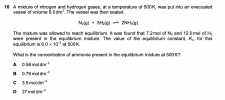An element X and compound YZ react separately with acid as shown.
X(s) + 2H+(aq) → X2+(aq) + H2(g)
YZ(s) + 2H+(aq) → Y2+(aq) + H2Z(g)
When 1.0 g of either X or YZ is reacted with an excess of acid, the total volume of gas formed is the same.
Which statements are correct?
1. Ar(X) = Mr(YZ)
2. X and Y are metals.
3. X and Y must both be in the same group of the Periodic Table.
Why is the answer "1 and 2 are correct"?
X(s) + 2H+(aq) → X2+(aq) + H2(g)
YZ(s) + 2H+(aq) → Y2+(aq) + H2Z(g)
When 1.0 g of either X or YZ is reacted with an excess of acid, the total volume of gas formed is the same.
Which statements are correct?
1. Ar(X) = Mr(YZ)
2. X and Y are metals.
3. X and Y must both be in the same group of the Periodic Table.
Why is the answer "1 and 2 are correct"?
